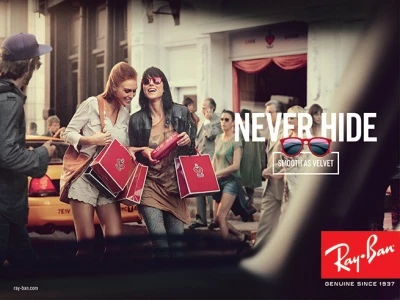Nothing beats the genuine Ray-Ban article
At AlphaOmega Glasses Repair, we handle broken Ray-Ban sunglasses daily, so we think we know a thing or two about sorting fake Ray-Bans from genuine.
Customers will sometimes ask for a Ray-Ban repair with genuine parts only to find out that the glasses they sent us are not real Ray-Bans.
With so many online deals and offers and, to be honest, some very high-quality fakes on the market, it is easy to get tricked into shelling out hard-earned cash for a fake pair of glasses.
As a registered dealer for genuine Ray-Ban sunglasses, we can compare authentic Ray-Bans with fake articles, so our repair experts have put together a few tips on spotting the real thing.
Feel the Ray-Ban quality
Genuine Ray-Bans are costly. They are hand-made from high-quality materials. Real acetate models like Ray-Ban Wayfarers are not manufactured using a mould but stamped out of a single acetate sheet and then hand polished. One of the first signs of fake Ray-Bans is the quality of the finish. Run your fingers over the frame and check for any rough edges, nicks, flaws and especially any seams in the plastic. A seam means that it was created from a mould – a dead giveaway for fake Ray-Bans.
Focus on the lenses
Many of the classic Ray-Ban models come with superior-quality glass lenses. Flick the lens gently with your fingernail, and you should hear the sharp 'ting' of quality glass. Don't panic if you don't – newer models have lenses made of high-quality plastic, but this is still a reliable test of older classic sunglasses. Check for lens quality by holding them up to bright light. The image in a genuine Ray-Ban lens should be crystal clear. All genuine Ray-Bans will have the logo etched into one of the lenses, and if polarised, they will have a 'Ray-Ban P' symbol. Check for the quality of the etching by running your finger over it. It should be perfectly smooth and cleanly etched. If it's not, it's probably a fake. Another test is to match the etching against a genuine logo from an advert or box. Pay particular attention to the size of the inner shapes of R and B. Even high-quality fakes can be spotted by noting slight differences in the logos. Genuine Ray-Ban logos will be identical.
It can all hinge on the frame
Models of Ray-Ban come with various hinges but always check for good-quality hinges embedded neatly into the frame with no trace of glue or melted plastic. Original Ray-Ban Wayfarers always come with a seven-barrel metal hinge with the barrel passing through seven interlocking hoops – fake Ray-Ban makers will often skimp on the hinges as they are usually out of sight.
Nosing out the fakes
Nose pads are another test of fake Ray-Bans. Most genuine metal Ray-Bans have transparent nose pads with the logo embossed centrally. Cheap fakes will fail to include logos on the nose pads. Another nose pad test is to check the shape. Ray-Ban nose pads will be contoured to the shape of the lens, while fakes will be straight or shaped differently from the lens.
Armed for serial action
Look for the familiar Ray-Ban logo on the temple arms. It should look clean and sharp, be correctly aligned and sit flush with the material. If the logo is stuck on, it will almost certainly not be genuine. Of course, ray-Ban models with thin arms, such as Aviators, won't have room for the logo. The serial number should be etched along the inside left arm, followed by two digits that give the lens and bridge width. On the right arm will be the R-B logo, the text 'Made in Italy' and a stylised 'CE', certifying that the sunglasses are sold in Europe. If any of these is missing or the text is poorly printed or not perfectly aligned with the frame, then suspect a fake. It's also good to check the serial numbers against those on the packaging.
The complete quality package
Poor quality packaging is another giveaway for fake sunglasses. First, check the large white shipping label on the end of the box. The label should contain the model number starting with RB or ORB, followed by four numbers. This model number is followed by a sub-model number of a single letter and a four-digit number, a pair of two-digit numbers for the lens and bridge widths. Finally, a lens code is always a single letter-digit combination (e.g. 2N). All new Ray-Bans come with a carrying case, polishing cloth and a booklet. Check them all for decent materials and a high-quality finish. Ray-Bans extends its quality feel to every detail, so the booklet, for example, should be flawlessly printed on quality paper, and the cleaning cloth should be silky smooth and come in a plastic bag.
Do Ray-Ban fakes matter?
If you are after a cheap pair of fake Ray-Ban sunglasses, then fair enough, but remember that you always get what you pay for. You should also be aware that fakes are regularly made in sweatshops where workers' health and safety, not wages, can leave much to be desired. Genuine Ray-Bans come with product warranties and, as fakes will be of much poorer quality than the originals, don't be surprised if they soon break. The real deal Ray-Bans may not be cheap, but they ooze quality, and fake ones can not only feel cheap but can also make the wearer look a bit cheap. One of the surest ways to be sure your Ray-Bans are genuine and original is to buy from an authorised dealer such as AlphaOmega Glasses Repair. Our products come directly from Italy and are guaranteed to be genuine Ray-Bans.


